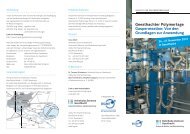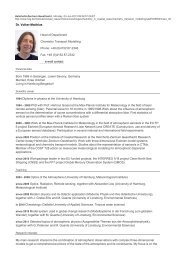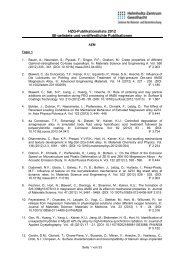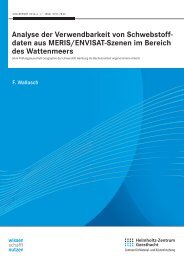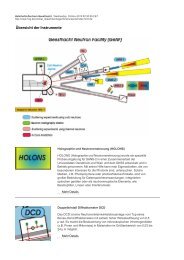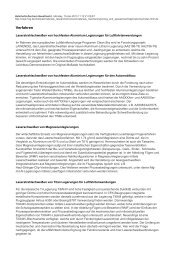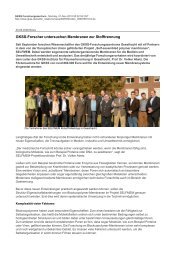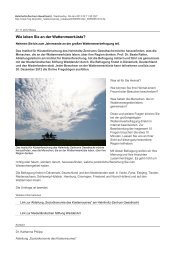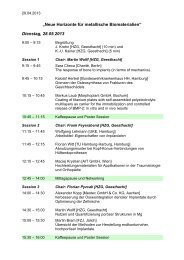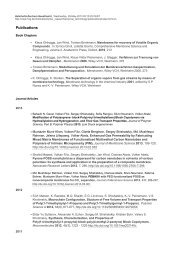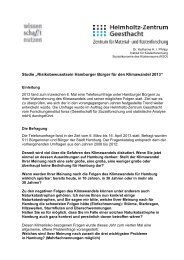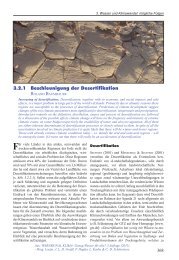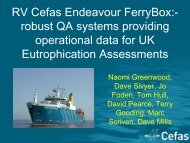BioSAXS - Helmholtz-Zentrum Geesthacht
BioSAXS - Helmholtz-Zentrum Geesthacht
BioSAXS - Helmholtz-Zentrum Geesthacht
You also want an ePaper? Increase the reach of your titles
YUMPU automatically turns print PDFs into web optimized ePapers that Google loves.
<strong>Helmholtz</strong>-<strong>Zentrum</strong> <strong>Geesthacht</strong> , 2013-04-26<br />
http://www.hzg.de/central_departments/genf/branch/desy/006201/index_0006201.html<br />
<strong>BioSAXS</strong><br />
EMBL – in cooperation with scientists at the <strong>Helmholtz</strong>-<strong>Zentrum</strong> <strong>Geesthacht</strong> – has built a SAXS beamline<br />
oriented towards biology/soft condensed matter. It will provide a wide range of spatial resolutions from about<br />
0.1 nm to 2000 nm and operate in the energy range from 4 to 20 keV. The focal spot on the detector will be 0.2<br />
(horizontal) *0.06 (vertical) mm. The expected flux on the sample will be in the order of 10 13 at wavelength<br />
resolution 3 *10 -4 (double crystal monochromator) and of order of 10 15 at wavelength resolution 1*10 -2 (pink<br />
beam or multilayers). The sample environment unit on <strong>BioSAXS</strong> at PETRA III allows fast mixing of solutions<br />
for time resolved measurements and automatic change of samples for fast screening robotic sample loading<br />
(10 μL and filling cycle 20 sec) is incorporated at the beamline using a device being constructed in<br />
collaboration between EMBL (outstations in Grenoble and Hamburg) and ESRF.<br />
The design of the instrument is shown in Fig. 1. The contribution of <strong>Helmholtz</strong>-<strong>Zentrum</strong> <strong>Geesthacht</strong> was the<br />
construction of the 5 m detector stage which allows recording of different scattering angular regimes by<br />
automatically changing the sample to detector distance in minutes time scale. High quality scattering patterns<br />
are recorded with a modern PILATUS 2M pixel detector. This single photon counting detector combines a high<br />
dynamic count range with low noise readout.<br />
First friendly users already collected data on several biological and biocolloidal systems at very low volumes.<br />
SAXS data of good quality and high performance are expected when the beamline reaches its final<br />
specifications. For future SAXS experiments with ultra-small sample volumes (< 1 nanoliter) microfluidic<br />
sample environments and fast mixing by stopped-flow technique are under development.<br />
Eventually the end-station is fully automated (sample loading, data collection, processing and preliminary<br />
analysis) and will rapidly provide users standard data concerning the size of the scattering structures (radius of<br />
gyration and maximum dimension).<br />
Upon operation of the beamline <strong>Helmholtz</strong>-<strong>Zentrum</strong> <strong>Geesthacht</strong> is in charge of 15 % of the total beam time.<br />
This will be supported by personnel of the <strong>Helmholtz</strong>-<strong>Zentrum</strong> <strong>Geesthacht</strong> and by contribution to the operation<br />
costs. Beside soft matter experiments aiming at the users visiting our SANS instrumentation at GEMS a strong<br />
focus will be on materials science related research (e.g. bio-membranes) which complements the protein and<br />
DNS focussed work performed at EMBL.<br />
Fig. 1: Experimental layout of the <strong>BioSAXS</strong> instrument at PETRA III<br />
Local Contact
Dr. Vasyl Mikhailovich Haramus (Beamline<br />
Scientist)<br />
Telefon: +49 (0)4152 87-1290<br />
Telefax: +49 (0)4152 87-1356<br />
E-Mail Kontakt<br />
Direct link to the electronic beamtime proposal form<br />
Electronic beamtime proposal form<br />
Link to EMBL <strong>BioSAXS</strong> website<br />
EMBL <strong>BioSAXS</strong> website<br />
Last update: April 25, 2013



